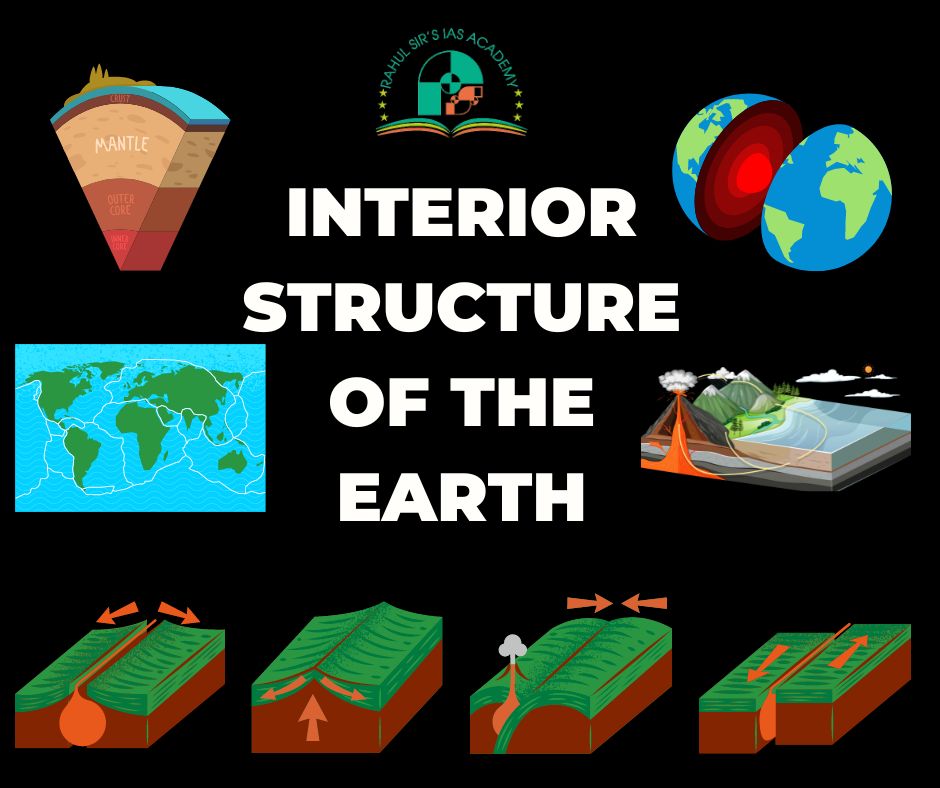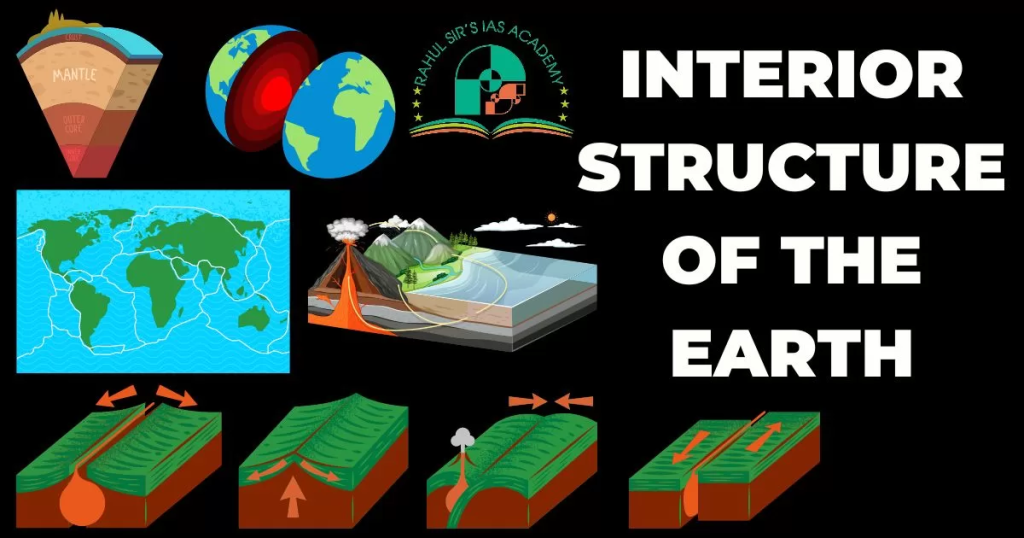
Introduction – Interior Structure Of The Earth

It is easy to study the atmosphere or outer space as compared to the interior structure of the earth. To study earth interior no probes can be sent as we do in the case of the atmosphere and outer space. Earth’s radius is around 6400 Km and the deepest man made drilling so far is a mere 12.4 Km. Thus ideas about the interior structure of the earth are based on indirect evidence. The structure consists of an outer silicate solid Crust around 50-70 km thick, a highly viscous Asthenosphere and solid Mantle around 2900 km thick, a Liquid outer core whose flow generates the Earth’s Magnetic Field, and a Solid inner core.
Constitution of the earth’s interior

Modern view of the earth’s internal structure takes into account evidences from many sources such as :
- Observations of Topography and Bathymetry.
- Observations of rocks brought out by volcanic activity.
- Measurements of gravitational and magnetic fields.
- Density studies: As the relative density of the earth has been calculated to be 5.5 gm/ cm3 and that of upper rocks to be 2.7 gm/ cm3 , the relative density of the in-depth rocks should be more than 5.5 .
More
- Temperature and pressure: Complex interplay of temperature and pressure largely determines the state of the matter in the interior of the earth. At the depth of 2900 km the temperature should be around 25,0000 C on which most of the earth’s interior would have melted but this is not so. The enormous amount of underlying pressure raises the melting point of the rocks.
- Seismic waves: Earthquake waves coming from within the earth is the most authentic source of information about the earth’s interior. These seismic waves are of three types.
- Primary waves ( P waves ) : Also called longitudinal waves or Compressional waves. These are analogous to sound waves and pass through both solid and liquid though they have the fastest speed in solid materials . Primary waves are fastest seismic waves , therefore they are recorded first on the seismograph followed by ‘S’ and ‘L’ waves.
- Secondary waves ( S waves) : Also called Transverse or Distortional waves, these are analogous to water ripples. S waves cannot pass through liquid materials.
- Surface waves ( L waves ) : Called as long-period waves, these are characterized with low-frequency long-wavelength, transverse vibrations. They affect the surface of the earth only and are the most destructive of all the waves. They also cover the longest distance of all the waves.

Seismic waves

Shadow Zones Of Seismic Waves
If the earth were a homogeneous solid sphere, seismic waves would be straight lines but the path of seismic waves are found to be curved indicating non-homogeneous structure of the earth. On the basis of the study of seismic waves and ‘seismic Tomography’, the spherical body of the earth is found to consist of three concentric layers as discussed below.
Earth’s Interior Layers – Internal Structure Of The Earth
Discontinuities
The Crust
- The thickness of this outermost layers ranges from 30-40 km beneath continents ( even more beneath mountains) to about 10 km beneath oceanic floor.
- The crust is divided into two shells — the upper, discontinuous , lighter layer of ‘sial’ ( silica + magnesium) . The Sialic shell is thicker under the continents and nearly disappears under the oceanic surface (composed of Sima).
- The layer that separates the upper and lower crust is known as Conrad Discontinuity.
- The earth’s surface is covered with the sedimentary rocks below which is a layer of crystalline rocks comprising granite and gneiss in its upper section and basaltic rocks in the lower section.
- This layer makes up only 1% of the entire volume of the Earth, though it makes up the entire surface (the continents and the ocean floor).
The Mantle
- The mantle is separated from the crust by a discontinue called Mohorovicic or Moho discontinuity where speed of ‘P’ wave suddenly goes up from 6.9 km/s to 7.9-8.1 km/s .
- The mantle extends from this discontinuity ( having average depth of 30-35 km ) to a depth of 2900 km. It accounts for 83 % of volume and 68 % of the mass of the earth .
- The mantle is composed of dense and rigid rocks which have pre-dominance of magnesium and iron.
- This layer , having mean density of 4.6 gm/cm3 , can be divided into two parts :
1. The upper mantle with a density of 3.3—4.0 extends down to 700 km.
2.The lower mantle of the mesosphere having density range of 4.0 – 5.5 extends between 700-2900 km.
- The layer that separates upper Mantle from Lower Mantle is known as Repetti Discontinuity.
The Core
- This innermost layer of the earth starts from the Weichert-Gutenberg discontinuity at the depth of 2900 km where there is abrupt reduction in P wave velocity and the disappearance of S waves ( which cannot pass through liquids).
- Thus , this part of the core, categorized as ‘Outer core’ (2900-5150 km) is in liquid state since the pressure at such great depths is also very high. The inner Core is solid.
- The layer that separates outer and inner Core is known as Lehmann Discontinuity. The core, also called barysphere, is composed of heavy metallic elements of Nickel and Iron (Nife).
- It counts for 16 % of volume and 32 % of the mass of the earth, with density ranging from 9.9 to 13.6 or even higher (average density being 11 g / cm3)
Mechanical Division Of Interior Structure Of The Earth
Earth inside can also be divided in a mechanical way.
Lithosphere and Asthenosphere: Another aspect of the interior structure of the earth is that the 80 to 100 km of the uppermost mantle on which the crust rests is cool and rigid like the crust and along with the crust behaves as a unit. This combined rigid part of crust and uppermost mantle is called the Lithosphere . Beneath this rigid layers of Lithosphere is the Asthenosphere the upper part of which is hot plastic and relatively soft. The depth of the Asthenosphere is regarded to be about 700 km roughly . The hot pliable character of the upper part of Asthenosphere facilitates the movement of overlying Lithospheric blocks, termed as Plates. Thus it provides the necessary lubrication for Plate tectonics
Continental Drift Theory
Continental Drift Theory
The theory of continental drifts was postulated by Alfred Wegener in 1915. In this he gave sound evidence to support the idea of the movement of continents over the surface of the earth. According to him ,about 250 million years ago, in the carboniferous period ,all the continents were united as a supercontinent known as Pangaea. This was surrounded by a large ocean, called Panthalassa . According to Wegener, Pangaea started breaking up in the carboniferous period. In his view, continents made up of lighter SIAL were moving over the ocean basins which are composed of denser SIMA.
The continents drifted in two directions towards the equator due to gravitational attractions of equatorial bulge (resulting in the formation of Himalayas, Alps, Atlas etc. ) and towards the west owing to tidal forces of the moon and the sun ( forming the mountains of Rockies and Andes). In order to maximize evidence for his theory, and overlook the absence of a mechanism, Wegener decided to draw from a variety of scientific fields including geology, geography, biology, and paleontology.
PLATE TECTONICS (Interior Structure Of The Earth)
Major & Minor Tectonic Plates
In the late 60’s the basic concepts of Wegener’s theory and seafloor spreading were united , in the light of great strides made in the field of earth sciences , into a much more encompassing theory known as Plate Tectonic. The revolutionary theory of plate tectonics provides the most rational explanation for the distribution of oceans and continents, orogenic, volcanic and seismic zones and related processes. The Theory of Plate Tectonics postulates that outer rigid lithosphere comprises a mosaic of rigid segments, called plates than move on the plastic upper mantle (asthenosphere), carrying the continents and oceans along with them. Their thickness varies from 80-100 km along the oceans to over 100 km in the continents. Six major and many minor plates have been identified.
Plate Boundary Interactions
All tectonic activities occur along the boundaries of the plate which are of three types:
- Diverging Boundary Interactions: Along this boundary marked by the oceanic ridge system , two plates move away from each other. Hot magma from the deep mantle erupts through cracks & fissures and spreads laterally forming a new crust. Hence these are termed as constructive boundaries. These are characterized by rift valleys, ridges , basaltic volcanism and shallow-foci earthquakes. The Mid-Atlantic system is the best example of this type.
- Convergent boundary Interactions: Along this Boundary , two plates towards each other . If both the plates are oceanic , one heavier plate boundary plunges down beneath the other along the oceanic trenches , resulting in formation of volcanic island arcs , Japan. If one of the plates is continental, the heavier oceanic plate boundary subducts beneath the continental one, forming Cordillera mountains such as Rockies and Andes. When both the plates are continental , no subduction occurs, volcanism ceases and plate edges & sediments are compressed, trusted and folded to form gigantic mountains like the Himalayas. High intensity earthquakes occur in this boundary interaction.
- Conservative / Transform Boundary Interaction: Here two plates just slide past each other along the transform fault. There is no volcanism, no crust is created or destroyed but strong earthquakes occur along the fault. Along the San Andreas fault of California, the American plate and Pacific plate move past each other and frequent earthquakes occur in these regions.
Conclusion On Interior Structure Of The Earth
On the whole it is easier to study things in space compared to understanding what is inside the earth. The deepest man made hole is just 12.7 km while the radius of the earth is 6400 km. With modern technology and simulation models understanding the interior structure of the earth has become somewhat easy. The theory of Plate Tectonics has revealed many mysteries. Now we know the exact causes of volcanism and earthquakes. The best part is that their occurrences can be predicted well in advance.
See Also
The Atmosphere – Structure And Composition
FAQs
Earth primarily has 3 layers namely Crust, Mantle and Core. These are separated by discontinuities . The individual layers also can be separated by internal and external layers.
Crust – 5 to 70 km thick. Mantle – 2,900 km thick. Outer Core – 2,200 km thick. Inner Core – 1,230 to 1,530 km thick.

